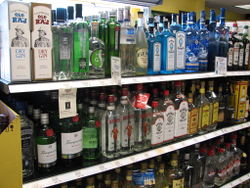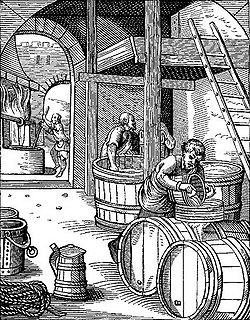Gin

Gin is a spirit whose predominant flavor is derived from juniper berries (Juniperus communis). Although several different styles of gin have existed since its origins, gin is broadly differentiated into two basic legal categories. Distilled gin is crafted in the traditional manner, by re-distilling neutral spirit of agricultural origin with juniper berries and other botanicals. Compound gin is made by simply flavoring neutral spirit with essences and/or other 'natural flavorings' without re-distillation, and is not as highly regarded. The minimum bottled alcoholic strength for gin is 37.5% ABV in the E.U., 40% ABV in the U.S.[1][2]
There are several distinct styles of gin, with the most common style today being London dry gin, a type of distilled gin. In addition to the predominant juniper content, London dry gin is usually distilled in the presence of accenting citrus botanicals such as lemon and bitter orange peel, as well as a subtle combination of other spices, including any of anise, angelica root and seed, orris root, licorice root, cinnamon, cubeb, savory, lime peel, grapefruit peel, dragon eye, saffron, baobab, frankincense, coriander, nutmeg and cassia bark. London dry gin may not contain added sugar or colorants, water being the only permitted additive.[2]
Some legal classifications of gin are defined only as originating from specific geographical areas (e.g. Plymouth gin, Ostfriesischer Korngenever, Slovenská borovička, Kraški Brinjevec, etc.), while other common descriptors refer to classic styles that are culturally recognized but not legally defined (e.g. Old Tom gin).
Contents |
Etymology
The name gin is derived from either the French genièvre or the Dutch jenever, which both mean "juniper".[3] The 1911 Encyclopædia Britannica states that the word gin is an abbreviation of "Geneva", both words being derived from the French genièvre (juniper).[4]
History
Juniper berries were recognized from ancient times as possessing medicinal properties. By the 11th century, Italian monks were flavoring crudely distilled spirits with juniper berries. During the bubonic plague, this drink was used, although ineffectively, as a remedy. As the science of distillation advanced from the Middle Ages into the renaissance period, juniper was one of many botanicals employed by virtue of its perfume, flavor, and medicinal properties.
The Dutch physician Franciscus Sylvius is credited with the invention of gin.[5][6] By the mid 1600s, numerous small Dutch distillers (some 400 in Amsterdam alone by 1663) had popularized the re-distillation of malt spirit or wine with juniper, anise, caraway, coriander, etc.,[7] which were sold in pharmacies and used to treat such medical problems as kidney ailments, lumbago, stomach ailments, gallstones, and gout. It was found in Holland by English troops who were fighting against the Spanish in the Eighty Years War and where the term Dutch courage came from. Gin emerged in England in varying forms as of the early 17th century, and at the time of The Restoration enjoyed a brief resurgence. It was only when William of Orange, ruler of the Dutch Republic, occupied the British throne together with his wife Mary in what has become known as the Glorious Revolution that gin became vastly more popular,[8] particularly in crude, inferior forms, where it was more likely to be flavored with turpentine.

Gin became popular in England after the government allowed unlicensed gin production and at the same time imposed a heavy duty on all imported spirits. This created a market for poor-quality grain that was unfit for brewing beer, and thousands of gin-shops sprang up throughout England, a period known as the Gin Craze. By 1740 the production of gin had increased to six times that of beer, and because of its cheapness it became popular with the poor. Of the 15,000 drinking establishments in London, over half were gin-shops. Beer maintained a healthy reputation as it was often safer to drink the brewed ale than unclean plain water. Gin, though, was blamed for various social and medical problems, and it may have been a factor in the higher death rates which stabilized London's previously growing population.[8] The reputation of the two drinks was illustrated by William Hogarth in his engravings Beer Street and Gin Lane (1751). This negative reputation survives today in the English language, in terms like "gin-mills" or "gin-joints" to describe disreputable bars or "gin-soaked" to refer to drunks, and in the phrase "Mother's Ruin," a common British name for gin.
The Gin Act 1736 imposed high taxes on retailers and led to riots in the streets. The prohibitive duty was gradually reduced and finally abolished in 1742. The Gin Act 1751 was more successful, however. It forced distillers to sell only to licensed retailers and brought gin-shops under the jurisdiction of local magistrates.[8] Gin in the 18th century was produced in pot stills, and was somewhat sweeter than the London gin known today.
In London in the early eighteenth century, gin sold on the black market was prepared in illicit stills (of which there were 1500 in 1726) and was often adulterated with turpentine and sulfuric acid.[9] As late as 1913, Webster's Dictionary states without further comment that 'common gin' is usually flavored with turpentine.'[10]
Dutch gin, also known as jenever or genever, evolved from malt wine spirits, and is a distinctly different drink from later styles of gin. Jenever is distilled at least partially from barley malt (and/or other grain) using a pot still, and is sometimes aged in wood. This typically lends a slightly malty flavor and/or a resemblance to whisky. Schiedam, a city in the province of South Holland, is famous for its jenever producing history. Jenever is typically lower in alcohol content and distinctly different from gins distilled strictly from neutral spirits (e.g. London dry gin). The 'oude' (old) style of Jenever, remained very popular throughout the 19th century, where it was referred to as "Holland Gin" or "Geneva Gin" in popular pre-prohibition bartender guides[11]. The column still was invented in 1832, making the distillation of neutral spirits practical. This invention would enable the creation of the "London dry" style, which was developed later in the 19th century.
In tropical British colonies, gin was used to mask the bitter flavor of quinine, which was the only effective anti-malarial compound. The quinine was dissolved in carbonated water to form tonic water, the resulting mix becoming the origin of today's popular gin and tonic combination, although modern tonic water contains only a trace of quinine as a flavoring.
Gin is a popular base spirit for many classic mixed drinks, including the martini. Secretly produced "bathtub gin" was commonly available in the speakeasies and "blind pigs" of Prohibition-era America due to the relative simplicity of the production method. Gin remained popular as the basis of many cocktails after the repeal of Prohibition.
Sloe gin is traditionally described as a liqueur made by infusing sloes (the fruit of the blackthorn) in gin, although modern versions are almost always compounded from neutral spirits and flavorings. Similar infusions are possible with other fruits, such as damsons (See Damson gin).
The National Gin Museum is in Hasselt, Belgium.
Cocktails with gin
Perhaps the best-known gin cocktail is the Martini, traditionally made with gin and dry vermouth. Other gin-based drinks include:
|
|
|
Gin is often combined with a number of other mixers.
Brands of gin
Notable brands
|
|
Historical brands
- Fleischmann's Gin - Marketed as the original American gin, first distilled in 1870[18]
- Hollands or Holland Gin - popular in seventeenth century England - strong flavour from distilling rather than added later
See also
- List of cocktails
References
- Deegan, Grant (Fall 1999). "From the bathtub to the boardroom: gin and its history". MY2K: Martini 2000 1 (1). http://www.mixology.com/issues/my2k/science/gin.htm.
- Dillon, Patrick (2002). The Much-lamented Death of Madam Geneva: The Eighteenth-century Gin Craze. London: Headline Review. ISBN 0-7472-3545-7.
- ↑ Definitions (“Standards of Identity”) for Distilled Spirits, Title 27 of the U.S. Code of Federal Regulations, Chapter 1, Part 5, Section 5.22 ,(c) Class 3
- ↑ 2.0 2.1 E.U. Definitions of Categories of Alcoholic Beverages 110/2008, M(b)
- ↑ Ciesla, William M (1998). Non-wood forest products from conifers. Food and Agriculture Organization of the United Nations. ISBN 92-5-104212-8. Chapter 8: Seeds, Fruits, and Cones. Retrieved July 27, 2006.
- ↑ http://www.1911encyclopedia.org/Gin Gin /geneva derived from the French word
- ↑ Origins of Gin, Bluecoat American Dry Gin, http://www.bluecoatgin.com/history_orgins.html, retrieved 2009-04-05
- ↑ Gin, tasteoftx.com, http://www.tasteoftx.com/spirits/gin.html, retrieved 2009-04-05
- ↑ R.J. Forbes; "A Short History of the Art of Distillation from the Beginnings up to the Death of Cellier Blumenthal; Brill Academic Publishers, 1997.";
- ↑ 8.0 8.1 8.2 Brownlee, Nick (2002). "3 - History". This is alcohol. Sanctuary Publishing. pp. 84–93. ISBN 1-86074-422-2.
- ↑ "Distil my beating heart". The Guardian (London). 2002-06-01. http://books.guardian.co.uk/reviews/history/0,6121,725676,00.html. Retrieved 2010-05-03.
- ↑ http://everything2.com/index.pl?node_id=246150
- ↑ Johnson, Harry; "Harry Johnson's New and Improved Bartender's Manual; 1900.";
- ↑ http://www.chefs-help.co.uk/drinkrecipe.php?nrecipe=5&item=Gin+Cocktail Maiden's Prayer
- ↑ Orange Blossom Cocktail Recipe from the Free Online Bartending School
- ↑ "COLA for Watershed Gin", TTB ID#10137001000189, Public COLA Registry, Alcohol and Tobacco, Tax and Trade Bureau, June 4, 2010.
- ↑ http://www.stortfordhistory.co.uk/guide2/walter_gilbey.html
- ↑ McGee, Harold (2009-12-02). "A Chill at the Still to Keep Flavors Fresh". The New York Times. http://www.nytimes.com/2009/12/02/dining/02curious.html. Retrieved 2010-05-03.
- ↑ Tanqueray Stats from Diageo
- ↑ Fleischmann's Gin
External links
- Gin news page - Alcohol and Drugs History Society
- Gin in Victorian London
|
|||||||||||||||||||||||||||||||||||||||||||||||||||||||||||||


